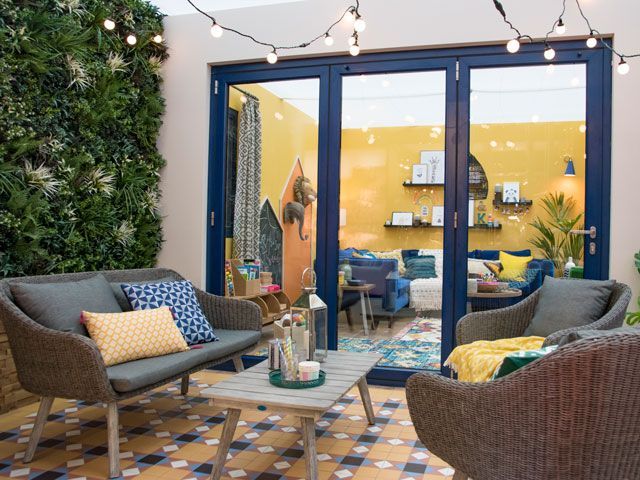
Image credit: Regatta
These small garden ideas will make the most of your outdoor space
While we’ve managed to overlook the shabby reality of a winter garden during the cold and miserable weather, spring is finally on its way and the promise of longer evenings and warmer days has us hankering for outdoor shindigs.
Google searches for ‘garden’ began to grow from the 19th of February and will peak in May, as many of us turn our attention to outdoor spaces in the hopes of a new season refresh.
For many of us, however, though we dream of entertaining in an oversized oasis, the reality is making do with whatever outside space we have.
Thankfully whether you have a baby balcony, a tiny courtyard, a petite patio or a dinky garden, there are some clever design tricks you can adopt to make it feel heaps bigger.
“As the days gradually lengthen and we inch closer to spring, our thoughts turn to rejuvenating our outdoor spaces, particularly smaller gardens, which can be transformed into personal sanctuaries with a few thoughtful additions and design solutions,” explain Jamie and Lou Graham, owners and interior design experts at Graham and Green.
From opting for flexi-furniture to going vertical with your planting, we spoke to interior experts for their easy decorating tips for a space that looks deceptively bigger and comes fully prepped for those sunny al-fresco get togethers.
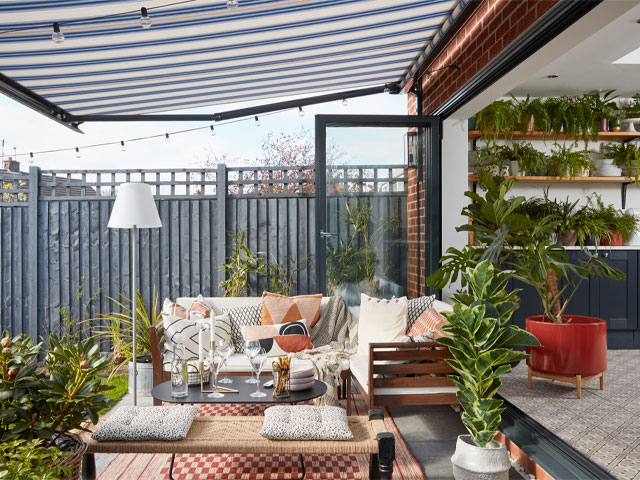
Add in a mirror
Hanging a mirror in your home’s exterior will reflect sunlight and make your outdoor area feel more open, creating the illusion of space.
“The strategic placement of an outdoor mirror serves as an excellent tactic in creating the illusion of a bigger garden, and when carefully placed, can reflect natural light and illuminate your outdoor space,” Jamie and Lou explain.
“For larger mirrors, consider propping up in areas with lots of natural light, to reflect across your garden. Likewise, position your mirror on the opposite side of a focal point, such as flower beds, or seating area to expand the perception of that space.”
For more compact mirrors, they recommend considering mounting at eye level onto fences or brick walls to add dimension to your outdoor area.

Go vertical
Vertical space is hugely important in a small garden, where often you have more space upwards than you do outwards.
“Think about growing plants on walls, training them upwards or hanging them from a structure such as trellis,” suggests Jenny Davis, from Forest Garden.
“Vertical structures that can serve multiple purposes are ideal, think privacy screening that can also provide support for climbing plants.”
Choose multi-functional fixtures
Clever multi-purpose use of design features is ideal for outdoor areas that are challenged in the square footage department. Jenny suggests using ones that work for two different purposes.
“Think about storage under bench seating rather than free-standing garden furniture,” she advises.
“Raised beds or linear planters that can also act as dividers.”
Tables that extend to accommodate extra guests are another excellent option for small outdoor dining spaces.

Opt for slim furniture
Bulky outdoor furniture can make a dinky garden even more cramped. Instead, opt for small-scale seating with clean, narrow lines.
“When working with limited outdoor space, choosing furniture that is sleek and slender can make a significant difference,” advises Jeannette Hudson, furniture expert at Online Sofa Shop.
“Look for pieces that have a minimal footprint, such as folding chairs and tables. These can be easily stored away when not in use, freeing up precious space.”
Keep it light
Light colours and materials can help create an illusion of openness and airiness in gardens or outdoor areas that are tight on space.
“Opt for furniture in hues like white, light wood, or metal, which reflect light and make the space feel more expansive,” advises Jeannette.
Choosing to go neutral tone in the overall space doesn’t mean you can’t incorporate some colour, however.
“Even a tiny space will appear livelier with colourful accessories, such as pillows, cushions or rugs in multi-coloured fabrics, or hand-painted pots,” advises Lee Heitzman, market manager at Trex for the UK and Ireland.
“Washing your outdoor entertaining space out with a bold colour can make a small area feel congested. Instead, choose natural and neutral tones as your backdrop – be it a deck or patio – to allow you the chance to add pops of colour that can flex with trends.”
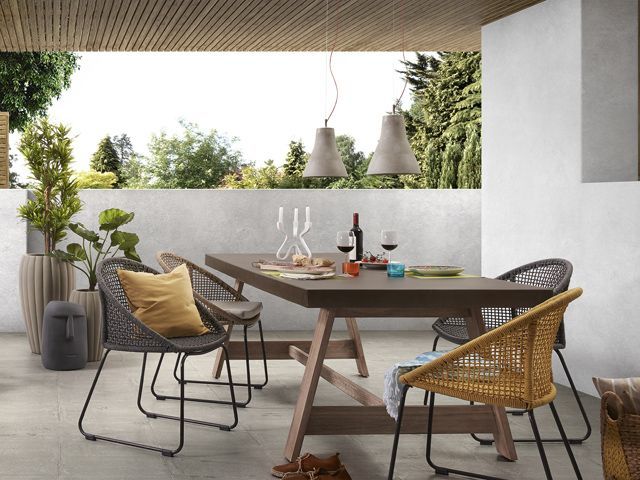
Arrange garden furniture strategically
It isn’t just about the outdoor furniture you choose, but also about where you place it.
“The layout of your outdoor dining space plays a crucial role in how spacious it feels,” explains Jeannette.
“Place furniture along the perimeter of the area to open up the centre and create a sense of flow.”
Create visual interest
Adding texture and depth to your outdoor dining area can make it feel more inviting.
“Outdoor rugs, cushions, and throws can provide warmth and cosiness without overwhelming the space,” Jeannette adds.

Minimise clutter
Just as clutter can make your interior rooms feel smaller, the same goes for outdoor areas.
“Resist the temptation to overcrowd your outdoor dining area with unnecessary accessories,” advises Jeannette.
“Choose a few statement pieces that enhance the space without overwhelming it.”
Embrace natural light
Maximising natural light is key to making any space feel larger, even in the garden.
“Keep sight lines open and trim back any foliage that obstructs sunlight,” Jeannette advises.
“Sheer curtains or shades can provide privacy without blocking out precious light.”
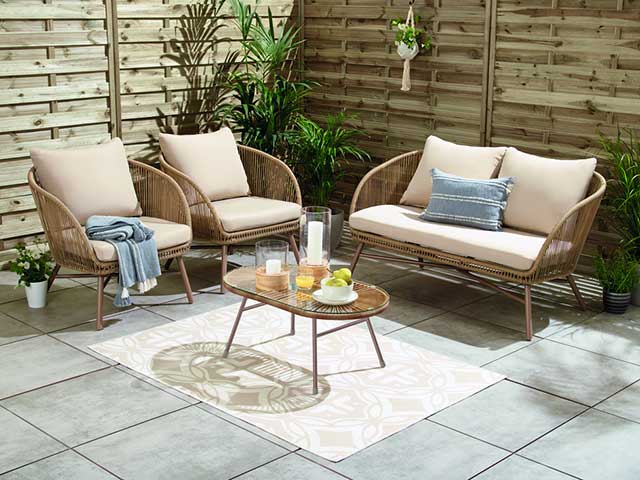
Consider the privacy aspect
Privacy is essential for creating a comfortable and intimate outdoor dining experience, particularly in a small space.
“Consider installing a privacy screen or trellis adorned with climbing plants to create a natural barrier,” suggests Jeannette.
“Hang curtains or shades around your dining area to block views from neighbouring properties.”
Tall planters filled with lush foliage can also provide privacy while adding beauty and greenery to the space.
“Strategic placing furniture and decor can help create cosy nooks and shield your dining area from prying eyes,” she adds.
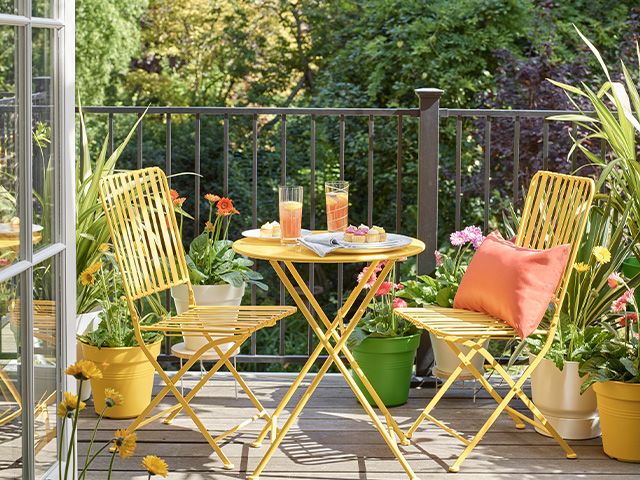
Balance is key
Less is more in a small garden but that doesn’t mean everything needs to be dinky.
“A lot of small elements can create a very cluttered feel, so you may be better off choosing bigger more dominant features and planting to balance the space,” advises Jenny.
“But at the same time, don’t overwhelm the space. Think simplicity.”
Consider zoning
Dividing your garden into zones will help create the illusion of extra space.
“However small the space might be, try to define different areas within it – just like inside your home,” advises Lee.
“Explore establishing separate areas for relaxing, cooking, dining and socialising. Pergolas are perfect for creating the look and feel of an ‘outdoor room’, helping to maximise the function and flow of your space.”
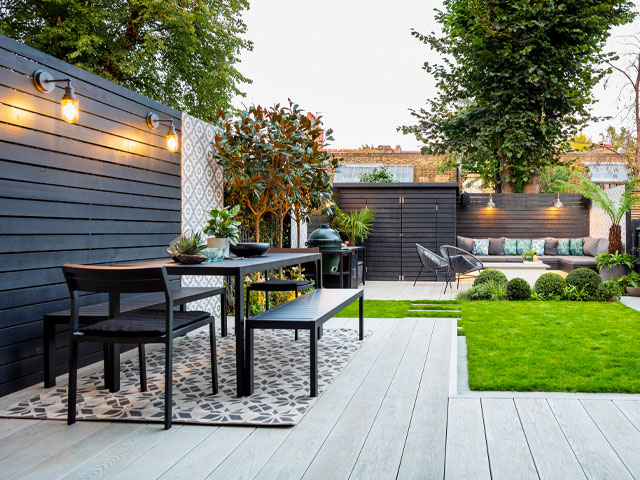
Go big on pots
In small garden spaces, pots and potted plants offer year round colour.
“You can easily switch up your plants in pots to keep them looking great,” advises Steph Chambers, seasonal buying manager at Dunelm.
She suggests opting for traditional stone finish pots to make the plants the hero, or for a more contemporary look, using really bright pots with foliage rather than flowers.
“Make sure you buy pots that are frost resistant, if you don’t have a shed/greenhouse to store them in over winter,” Steph adds.
“Fewer big pots will be much easier to care for than lots of small pots, as they’ll hold more water.”
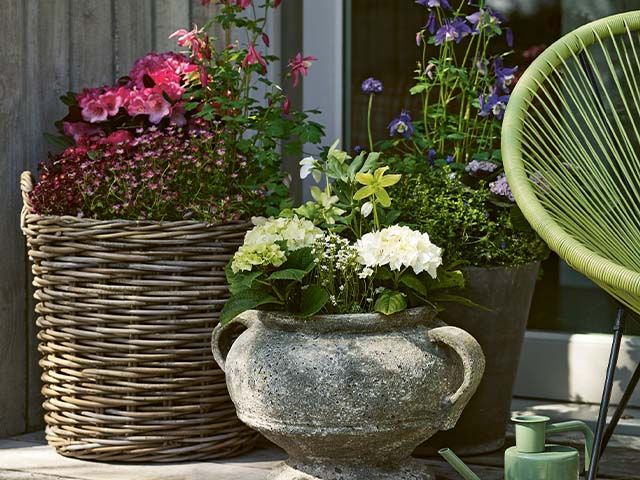
Create an outdoor ‘room’
Make a small outdoor area feel bigger by making it feel like a continuation of your indoor space.
“When you have a smaller space, it’s really easy to make it feel cosy with lights, cushions and throws to create an outdoor room,” explains Steph.
“It is much easier to create this kind of outdoor room in a small garden/balcony, than it is in a big garden. Outdoor rugs are also great for covering up ugly concrete floors or patios, and you can wash them down with a hose to keep them clean.”




